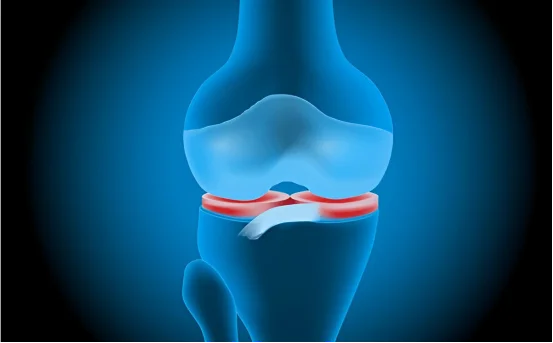The knees support every movement you make, whether it’s walking, running, jumping or standing. The menisci, two C-shaped cartilage pieces located between the femur (thighbone) and the shinbone(tibia), are key structures for knee stability and shock absorbency. These menisci may tear due to sudden twisting movements, sports or age. Understanding of what is meniscus repair surgery.
Doctors may recommend Meniscus Repair Surgery when a tear occurs. This procedure restores torn cartilage, and helps maintain the knee’s function over time.
What Is Meniscus Repair Surgery?
Meniscus Repair Surgery is an minimally invasive orthopaedic procedure that aims to sew or anchor the torn tissue rather than remove it. The goal of the procedure is to restore natural cartilage and maintain knee cushioning.
The procedure is typically performed by arthroscopic. This means that a small camera, surgical instruments and a tiny incision are made around the knee. The surgeon will decide whether to repair the meniscus or remove it in part, depending on its location and pattern.
Why do meniscus repair surgeries occur?
Not all tears of the meniscus require surgery. Some small tears at the outer edge of a meniscus, which has a greater blood supply, may heal by themselves with physical therapy and rest. is usually required when:
- The tear is deep, large or unstable
- Symptoms persist despite conservative treatment
- The tear is located within the vascular zone (red-red), which has healing potential
- The patient is athletic and young
- The tear can cause locking or interfere with normal knee movements.
Repairing the meniscus is preferable to removing it because this reduces the risk of arthritis in the knee, and also improves the long-term health of the joint.
Meniscus Tear Symptoms
Patients who have a torn lateral meniscus experience these symptoms:
- Sharp or stabbing Knee pain
- Swelling occurs within 24 hours of injury
- The injury may cause a popping sensation
- Legs are difficult to bend or straighten
- Knee locking
- Feeling of Instability in the Joint
It’s important to be diagnosed and determine if meniscus surgery will work for you.
Diagnosis – How to Confirm a Meniscus Tear?
Your orthopedic specialist will perform the following tests to confirm a tear of the meniscus:
- Perform a physical examination including special knee movements (like McMurray’s test).
- Review the medical history of your injury and its mechanism.
- Order imaging tests in particular:
- An MRI scan provides a detailed look at soft tissues such as the meniscus
- An X-ray is used to rule out arthritis or fractures.
Your surgeon will determine the best course-of-action based on the type, location and severity of the tear. This may be conservative treatment or surgical interventions.
What happens during meniscus repair surgery?
Meniscus repair surgery usually follows these steps.
- Anesthesia:- You can choose between general anesthesia or regional anesthesia depending on your condition and preferences.
- Arthroscopic Access:- A small camera (arthroscope), which is inserted through a keyhole, allows the surgeon to see the damage.
- Meniscus Evaluation:-It is important to evaluate the tear’s shape, size and location.
- Repair Technique:- The torn meniscus edges are stitched together or fixed with absorbable stitches, or implanted.
- Closure & Recovery:- Incisions are then closed and bandages applied. After the operation, the patient is closely monitored and usually discharged on the same day.
Recovery after Meniscus Repair Surgery
Meniscus Repair Recovery is longer than meniscectomy but has better long-term results. What to expect
- In the first 2 weeks, you may need crutches; a knee brace is worn to provide support.
- Weeks 3 to 6: A gentle physical therapy is started in order to restore movement.
- Weeks 6- 12: Strengthening Exercises are introduced.
- After 3-6 months, Under doctor’s guidance, return to sport or vigorous activity.
It is important to follow the rehabilitation protocol for a successful recovery. If you rush through recovery or skip physiotherapy, this can increase your risk of retear.
Complications and Risks
Meniscus repair surgery, while generally safe, has potential risks.
- Infection and bleeding
- Joint stiffness or stiffness
- Recurrence of the repair
- Nerve or vessel injury (rare)
- Blood clots
By choosing a highly-skilled orthopedic surgeon and adhering to post-op instructions, you can reduce the risk of complications.
Alternatives for Meniscus Repair
Some patients will be offered the following treatment options depending on their tear:
- Conservative treatment: RICE (Rest, Ice, Compression and Elevation), NSAIDs and physical therapy
- Partial Meniscectomy: Surgical trimming the torn part (for avascular zones tears)
- Meniscus Transplantation: In cases of complete meniscus damage.
Your doctor can help you weigh the advantages and disadvantages based on your age, level of activity, and tear characteristics.
Conclusion
What is Meniscus Repair Surgery , can restore knee health in active and young individuals. Don’t ignore persistent knee pain or swelling caused by a torn, swollen, or locked meniscus.
Early diagnosis and treatment can help you to avoid joint damage and preserve your mobility.






















